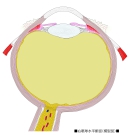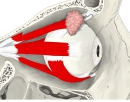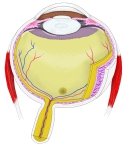


・「欠陥に乏しく白色を呈するが、小児ではやや青い光沢があり、老人では黄色が加わる。」(日本人体解剖学)




最厚:視神経進入部付近が最も厚く(1~2㎜) ※参考:日本人体解剖学
最薄: 眼筋の付着する付近が最も薄い(0.4~0.5㎜)
「強膜の厚さは眼球後極で~1.0mm、前部で~0.6mm、赤道で~0.4mmである。」(船戸和也のHP)


強膜は外層より以下の3層構造を呈する。
| 強膜の3層構造 |
1 |
強膜上皮 |
| 2 |
強膜固有質 substantia propria of sclerae
「強膜固有質は少量の弾性線維の混じった、交織膠原線維性結合線維よりなる。 」(船戸和也のHP) |
| 3 |
強膜褐色板 lamina fusca sclerae
「強膜褐色板は強膜とその内側につづく脈絡膜との間の疎性結合組織の層。混在する色素含有細胞で黄褐色の概観を示す。。 」(船戸和也のHP) |
※Wikipediaでは以下のように4層構造としている。
episclera(上強膜) stroma(強膜固有質) lamina fusca(強膜褐色板) endothelium((血管)内皮)

|
 |
|
眼球(縦断面) |
眼球(横断面) |
眼窩部(縦断面) |
 |
|
 |
右眼筋(側面) |
眼球と神経 |
眼球・横断面-1 |
 |
|
|
眼球・横断面-1 |
|
|


以下は「Wikipedia」の解説文となる。
The sclera, also known as the white of the eye or, in older literature, as the tunica albuginea oculi, is the opaque, fibrous, protective, outer layer of the human eye containing mainly collagen and some crucial elastic fiber. In humans, and some other vertebrates, the whole sclera is white, contrasting with the coloured iris, but in most mammals, the visible part of the sclera matches the colour of the iris, so the white part does not normally show while other vertebrates have distinct colors for both of them. In the development of the embryo, the sclera is derived from the neural crest.In children, it is thinner and shows some of the underlying pigment, appearing slightly blue. In the elderly, fatty deposits on the sclera can make it appear slightly yellow. People with dark skin can have naturally darkened sclerae, the result of melanin pigmentation.
The human eye is relatively rare for having a pale sclera (relative to the iris). This makes it easier for one individual to identify where another individual is looking, and the cooperative eye hypothesis suggests this has evolved as a method of nonverbal communication.
【 語 句 】
・opaque:不透明な、くすんだ ・crucial:重大な ・elastic fiber:弾性繊維 ・vertebrates:脊椎動物 ・iris:虹彩 ・distinct:はっきりとした ・embryo:胎芽 ・neural crest:神経堤 ・pigment:色素 ・melanin pigmentation:メラニン色素沈着 ・cooperative eye hypothesis:協調的な目仮説 ・nonverbal communication:非言語的意思疎通
【
Structure】
The sclera forms the posterior five-sixths of the connective tissue coat of the globe. It is continuous with the dura mater and the cornea, and maintains the shape of the globe, offering resistance to internal and external forces, and provides an attachment for the extraocular muscle insertions. The sclera is perforated by many nerves and vessels passing through the posterior scleral foramen, the hole that is formed by the optic nerve. At the optic disc the outer two-thirds of the sclera continues with the dura mater (outer coat of the brain) via the dural sheath of the optic nerve. The inner third joins with some choroidal tissue to form a plate (lamina cribrosa) across the optic nerve with perforations through which the optic fibers (fasciculi) pass. The thickness of the sclera varies from 1 mm at the posterior pole to 0.3 mm just behind the rectus muscle insertions. The sclera's blood vessels are mainly on the surface. Along with the vessels of the conjunctiva (which is a thin layer covering the sclera), those in the episclera render the inflamed eye bright red.
【 語 句 】
・connective tissue:結合組織 ・dura mater:硬膜 ・cornea:角膜 ・extraocular muscle:外眼筋 ・optic nerve:視神経 ・optic disc:視神経円板 ・choroidal:脈絡膜の ・lamina cribrosa:篩板 ・fasciculi:束 ・rectus muscle:直筋 ・conjunctiva:結膜 ・renderAB:AをBにする ・episclera:上強膜 ・inflamed:炎症を起こした
In many vertebrates, the sclera is reinforced with plates of cartilage or bone, together forming a circular structure called the sclerotic ring. In primitive fish, this ring consists of four plates, but the number is lower in many living ray-finned fishes, and much higher in lobe-finned fishes, various reptiles, and birds. The ring has disappeared in many groups, including living amphibians, some reptiles and fish, and all mammals.
The eyes of all non-human primates are dark with small, barely visible sclera.
【Histology】
The collagen of the sclera is continuous with the cornea. From outer to innermost, the four layers of the sclera are:
【 語 句 】
・cartilage: ・sclerotic ring:強膜輪 ・ray-finned fish:条鰭類 ・lobe-finned fishes:総鰭類 ・reptile:爬虫類 ・amphibian:両生類 ・primate:霊長目の動物
The sclera is opaque due to the irregularity of the Type I collagen fibers, as opposed to the near-uniform thickness and parallel arrangement of the corneal collagen. Moreover, the cornea bears more mucopolysaccharide (a carbohydrate that has among its repeating units a nitrogenous sugar, hexosamine) to embed the fibrils.
The cornea, unlike the sclera, has five layers. The middle, thickest layer is also called the stroma. The sclera, like the cornea, contains a basal endothelium, above which there is the lamina fusca, containing a high count of pigment cells.
Sometimes, very small gray-blue spots can appear on the sclera, a harmless condition called scleral melanocytosis.
【 語 句 】
・mucopolysaccharide:ムコ多糖類 ・nitrogenous:窒素の ・hexosamine:ヘキソサミン ・embed:はめ込む ・fibril:原繊維 ・stroma:間質、基質 ・endothelium:血管内皮 ・lamina fusca:褐色板 ・pigment cell:色素細胞 ・scleral melanocytosis:強膜性黒色細胞腫?
【Function】
Human eyes are somewhat distinctive in the animal kingdom in that the sclera is very plainly visible whenever the eye is open. This is not just due to the white color of the human sclera, which many other species share, but also to the fact that the human iris is relatively small and comprises a significantly smaller portion of the exposed eye surface compared to other animals.
It is theorized that this adaptation evolved because of our social nature as the eye became a useful communication tool in addition to a sensory organ. It is believed that the conspicuous sclera of the human eye makes it easier for one individual to identify where another individual is looking, increasing the efficacy of this particular form of nonverbal communication, called cooperative eye hypothesis. Animal researchers have also found that, in the course of their domestication, dogs have also developed the ability to pick up visual cues from the eyes of humans. Dogs do not seem to use this form of communication with one another and only look for visual information from the eyes of humans.
【 語 句 】
・comprise:構成する ・theorize:理論を立てる ・evolve:進化する ・conspicuous:はっきり見える ・nonverbal communication:非言語的意思疎通 ・cooperative eye hypothesis:協調的な目仮説
■ 写真やイラストを掲載しているサイト ■
・ イラストや写真を掲載しているサイト-Ⅰ
・ イラストや写真を掲載しているサイト-Ⅱ
・ イラストや写真を掲載しているサイト-Ⅲ
・ イラストや写真を掲載しているサイト-Ⅳ
